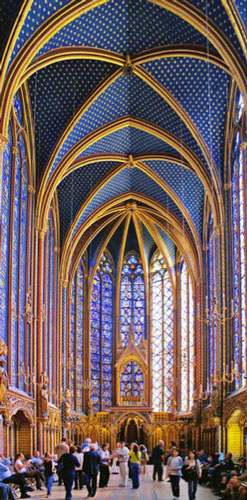
Wikimedia Commons
Sainte-Chapelle was built in Paris from 1241-1248 by the greatest of the French medieval kings, Louis IX. It served as the royal chapel and a repository for a number of purported Holy Relics including fragments of the Crown of Thorns and Christ’s Cross. It is two-stories high with a parish church used by the public on the ground floor while the king and his court worshipped in the main chapel on the upper floor. In the upper chapel, except for the dado zone the exterior walls of the church are reduced to a minimal skeletal form. The stone skeleton extends upward to support the delicate groin vaults that form the ceiling structure and the walls are in-filled with a stunning expanse of brilliant stained glass.

Sainte-Chapelle Is perhaps the greatest example of Rayonnant style of the French Gothic. The style is characterized by a greater concern for two dimensional surfaces and the appearance of structural lightness. More of the wall surface than ever before was pierced by windows with the desire to maximize the quantity of light admitted into the church. Sainte-Chapelle achieved this through the use of two innovative constructional techniques. First, was the use of a sophisticated external buttressing system, and second, the use of encircling iron chains hidden in the window tracery. Both were used to resist the substantial outward thrust of the roof in a visually minimal manner.
The visual effects of the chapel are astounding. The interior is completely saturated in light from the large and colorful windows. The slender and elongated collonettes soar dramatically upward drawing one’s eye to the ribbed vaulting and ceiling above. The color of the blue ceiling and the blue glass closely match and appear to blend into one and fully envelope the viewer in a heavenly cloak.